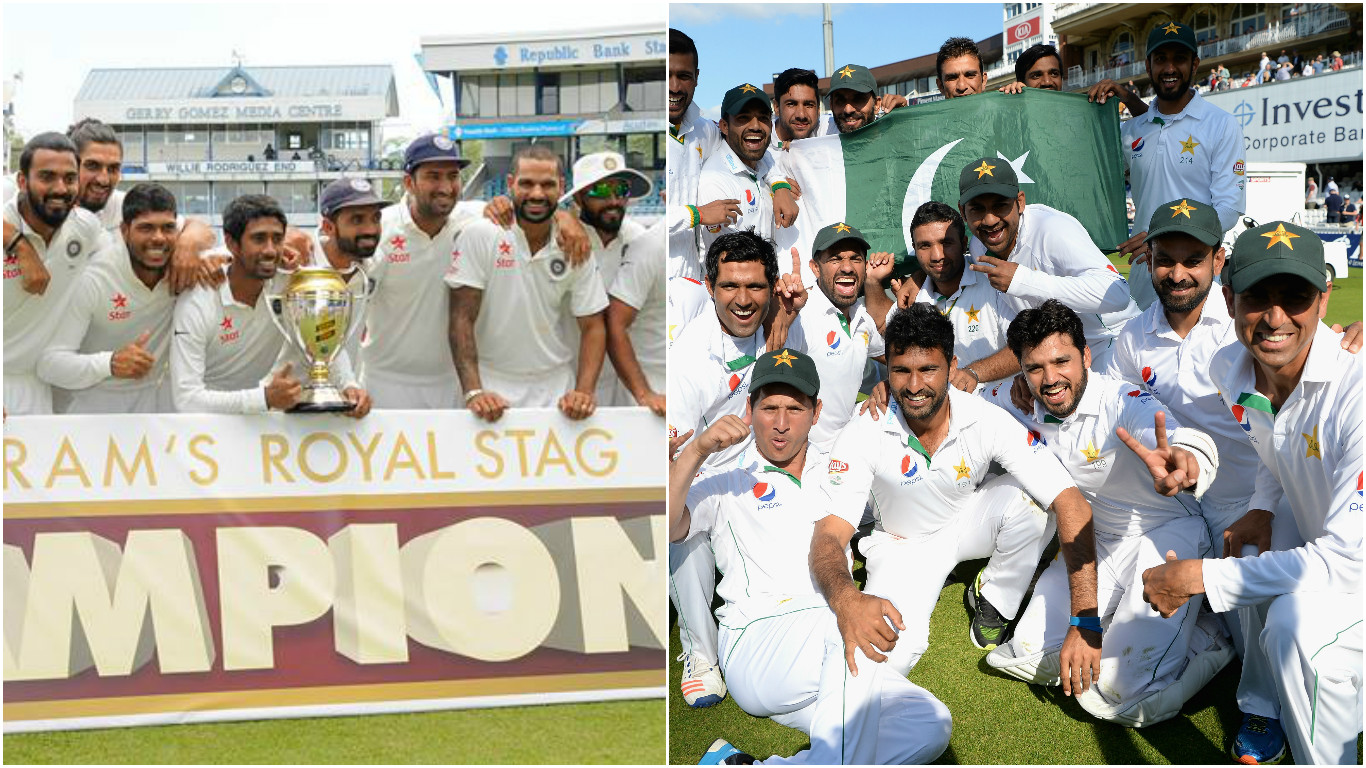The story of how Pakistan pipped India to the No.1 spot in ICC Test rankings on Monday
Just five days after becoming the No.1 team in the Test rankings, India were dethroned by their neighbours Pakistan on Monday. India’s demotion to No.2 and Pakistan’s rise to the top were all too quick, and even after winning the series 2-0, India were forced to settle for the 2nd position.

Timeline of the rankings in the last one month:
July 21 (The start of India’s tour of West Indies) - 1. Australia (118), 2. India (112), 3. Pakistan (111)
August 14 (The end of Pakistan’s Test series against England) - 1. Australia (118), 2. India (112), 3. Pakistan (111)
Pakistan drew the Test series 2-2 and retained their rating.
August 17 (The end of Australia’s Test series against Sri Lanka) - 1. India (112), 2. Pakistan (111), 3. Australia (108)
Australia lost the series 3-0 and lost 10 ratings in the process.
August 22 (The end of India’s Test series against West Indies) - 1. Pakistan (111), 2. India (110), Australia (108)
India won the series against West Indies 2-0, but lost two ratings in the process because of West Indies’ low ranking, while India needed to win the series 3-0 to retain their ratings.
Trying to look at the scoring system, however, to understand how this happened can be absolutely befuddling. With the ICC employing a complex system, there are rankings, points, and ratings in the mix.

Although England
Here is a simple guide to
Also, read : MS Dhoni and Virat Kohli | Captain Cool v Captain Aggressive
So how do ICC rankings work?
1. To begin with, teams are ranked according to their rating, only the rating. The higher the rating, the higher the place in the rankings. ICC allocates points to every Test match played by a team, and the average of the points under the period of consideration is then taken to get the rating.
This score from the series is then added to their overall points and is then divided by the number of matches to arrive at the ratings. So,
Ratings = Points/Matches; India’s rating = 2748/25 = 109.92 (110)
2. Calculation of the rating points also depends on the strength of the opposition.
1 point for a win and 0.5 for a draw.
The rating a team receives from a win or a defeat will depend on the strength of the opposition. In the case of a draw, the rating system will benefit the lower-ranked team. The points awarded to each team after a Test/series are also based on the strength of the opposition. A win against a higher-ranked opponent will increase the team’s ratings, while a defeat against a lower-ranked opponent will take the team the other way.
Apart from the points allocated for winning Test matches, the teams will also receive a bonus point for winning the series equal to that of a Test win. Thus in addition to the points for the wins and draws in the Series, a team will get additional one point for the series win. So, although Sri Lanka won the series
Two methods are used to find the ratings
Ø The team’s points from the series * 50 points more than the opposition’s rating points + the opposition’s series points * 50 points less than the opposition's rating points.
For example, At the start of the Test series between Sri Lanka and Australia, the Aussies were at the top of the rankings with 118 ratings and Sri Lanka were seventh with 85 ratings.
The rating difference between the two teams was 35 and the first method came into the equation. Sri Lanka got game points from the series, while Australia got 0.
That is, 4 * (50 + 118) + 0 (85-50) = 672 for Sri Lanka and 0 * (50 + 85) + 4 * (118-50) = 272
The series between India and West Indies will be the best example for the second scenario, where the difference between the two team’s rating points is 40 or more.
At the start of the series, India had 112 ratings and West Indies had 65 ratings. India won the series 2-0 and got four points from the series (2 wins, 2 draws, and a bonus), while West Indies got one point (2 draws).
In that scenario, the higher-ranked team will get:
Ø Team’s series points (that will be 4 for India) * 10 points more than the team’s own rating + Opposition’s series points (1) * 90 points less than the team's own rating.
That is, 4 * (10 + 112) + 1 * (65 - 112) = 535 points for India
The lower-ranked team will get:
Ø Team’s series points * 90 points more than the team’s own rating + Opposition’s series points * 10 points less than the team’s own rating.
That is , 1* (90 + 65) + 4 * (65 - 10) = 375 for West Indies
This score from the series is then added to their overall points and is then divided by the number of matches to arrive at the ratings.
4. A minimum time period of 36 months or a maximum of 48 months
5. The first two years which are under consideration will receive 50%
How did India slip to No.2 after going to No.1?
After Sri Lanka won the series 3-0, Australia lost their place at the top of the rankings. Thanks to their neighbours’ victory, India became No.1 albeit for a short period. Virat Kohli and his team started their tour of the Caribbean with 112 ratings, six behind the Australians. West Indies were 8th in the ranking with 65 ratings and India needed a 3-0 series win to continue with the same rating.
Although India went to the top of the rankings before the fourth Test at Queen’s Park Oval, a draw in the last Test saw them dropping two points in the series. Even though India won the series 2-0, the win against a lower-ranked opponent did not help them much on the ratings. They received 535 points from the
So, how did Pakistan became No.1?
At the start of the series between England and Pakistan, the teams were fourth and third respectively in the rankings. Pakistan had 111 ratings, and England had 108. The teams drew the four-Test series 2-2, and with just three rating points separating the two, both teams maintained their positions initially in the rankings without dropping any rating points.
What is the problem with the current system of rankings?
As expressed by many, the lack of
India had a historic series in the Caribbean, and they won more than one Test in a series in the Caribbean for the first time, but West Indies’ low rank harmed India’s chances of becoming the No.1. Had there been an away
When can India become No.1 next?
India will have their chance to regain the No.1 spot in September–October when New Zealand, who are fifth in the rankings, arrive in India for a three-Test series. With Pakistan and Australia scheduled to play only in November, India can reach the top of the rankings even with a 1-0 victory against the Kiwis.
Also, read : Virat Kohli | Evolution of a brattish talent to a global superstar

Comments
Sign up or log in to your account to leave comments and reactions
0 Comments